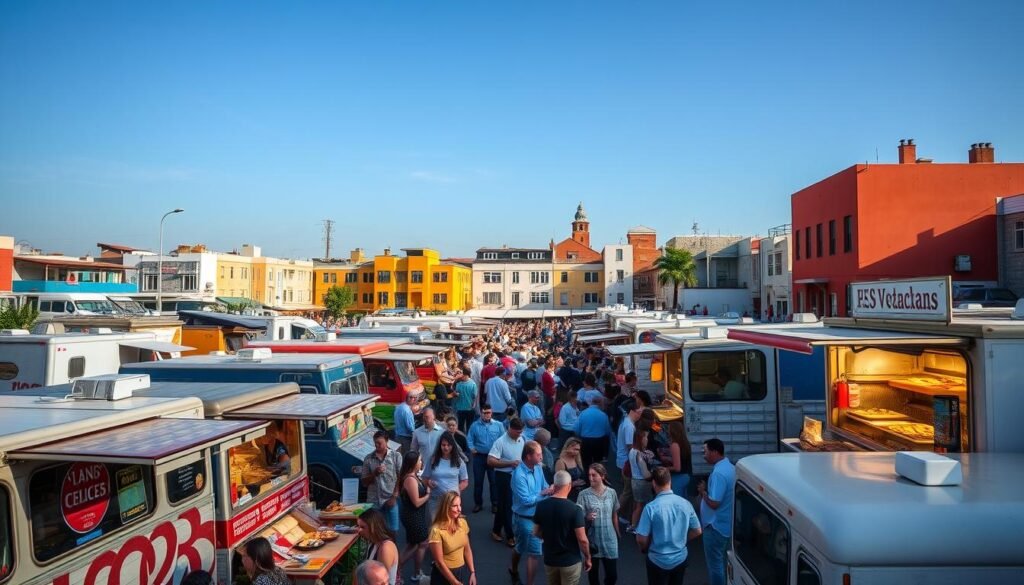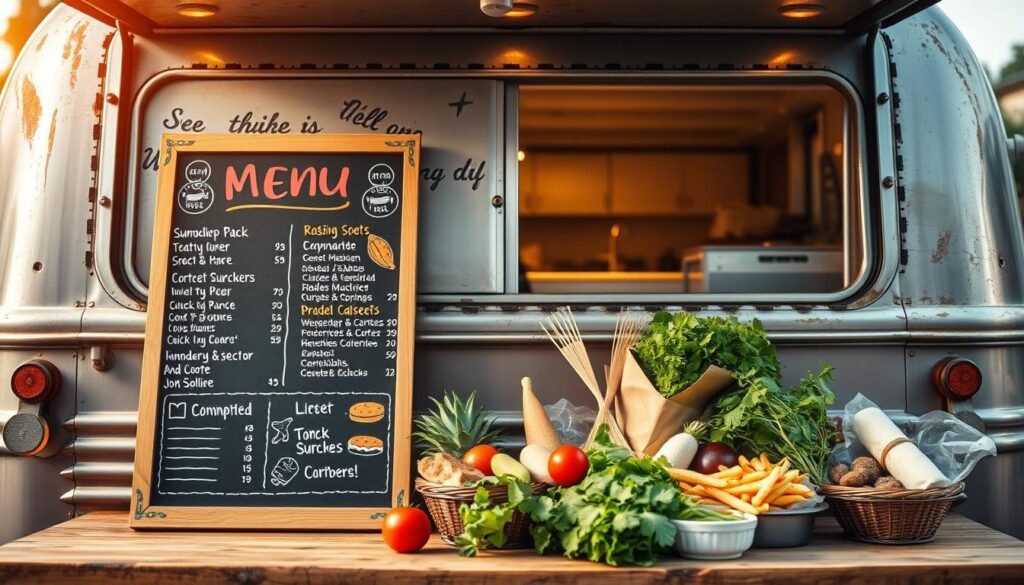Have you ever dreamed of running your own culinary venture without the high costs of a traditional restaurant? The food truck industry, valued at over $2.7 billion in the U.S., offers a flexible and affordable way to break into the food service business. With more than 30,000 mobile eateries nationwide, this booming sector thrives on creativity and mobility.
Unlike brick-and-mortar restaurants, launching a mobile kitchen requires significantly lower upfront investments—averaging around $100,000 compared to $1 million or more. Whether you’re serving gourmet tacos or artisanal desserts, standing out with a unique concept and strategic location is key.
From securing permits to designing a mouthwatering menu, this guide covers the essentials. Social media marketing and platforms like CloudKitchens also provide modern alternatives for virtual food businesses. Ready to hit the road?
Key Takeaways
- The U.S. food truck industry is worth over $2.7 billion.
- Startup costs are far lower than traditional restaurants.
- Unique concepts and prime locations drive success.
- Social media plays a crucial role in marketing.
- Permits, equipment, and funding are critical steps.
Why Start a Food Truck Business?
California leads the nation with 750+ mobile eateries, proving this model works. The industry has grown 12% annually since 2017, outpacing traditional dining. With lower costs and unmatched flexibility, it’s no surprise entrepreneurs are flocking to this space.
The Growing Popularity of Food Trucks
Mobile kitchens thrive at festivals, office parks, and neighborhoods. Brands like Kogi BBQ in LA and Curry Up Now in San Francisco show how unique concepts attract loyal fans. Social media buzz amplifies their reach, turning viral posts into long lines.
Data reveals 39% of owners use customer insights to refine menus. This agility keeps offerings fresh and relevant. Unlike static locations, trucks can pivot to high-demand areas instantly.
Advantages Over Traditional Restaurants
Launching a small business on wheels costs $40,000–$250,000—far less than a restaurant’s $1M+ price tag. No dining space means lower rent and utilities. Staffing is simpler too, with fewer employees needed.
Mobility creates multiple revenue streams. A single truck can serve lunch downtown, then cater a private event at night. Permits average $28,276 nationwide, but the 30% lower failure rate makes it a safer bet.
Customers love the convenience and creativity. From gourmet tacos to vegan desserts, standing out is easier with a focused menu. The key? Find your niche and own it.
How to Start a Food Truck: Step-by-Step Process
Launching a mobile eatery begins with strategic planning and smart research to stand out in a competitive market. Whether you’re serving gourmet sliders or vegan bowls, understanding local demand and crafting a unique brand are critical first steps.

Conduct Market Research
Identify high-traffic locations and underserved cuisines using tools like Food Truck Nation. In Sacramento, dessert trucks fill only 12% of the market—a golden opportunity for niche players.
Analyze competitors with a 3:1 customer-to-truck ratio for ideal profitability. Pop-up events help test your concept before committing to a full build-out. Square POS data can reveal peak demand times and popular dishes.
Develop Your Food Truck Concept
Streamline your menu with 5–7 core ingredients to control costs and simplify operations. Aim for food expenses at 30–40% of the sale price, as seen in top-performing UK models.
Your brand identity—name, logo, and truck wrap—should reflect your culinary vision. In California, commissary kitchen rules vary by county, so factor these into your plan early.
Creating a Food Truck Business Plan
Financial clarity and strategic planning form the backbone of every successful mobile kitchen. A detailed business plan not only secures funding but also maps operational workflows and revenue targets. Industry data shows trucks with formal plans achieve 40% higher survival rates in their first three years.
Key Components of a Business Plan
Effective plans contain seven core sections. The executive summary highlights your unique value proposition, while market analysis identifies ideal locations and customer demographics. Operations details should include EPA-compliant waste disposal—a requirement in 42 states.
Equipment financing options typically offer 3-7 year terms, with SBA loans covering 50-85% of costs. Include insurance requirements like $1 million liability coverage. Successful operators allocate 12-15% of startup budgets for unexpected expenses.
Financial Projections and Funding
Calculate your break-even point using an $8-$15 average ticket price. Sample P&L statements show 60% gross margins are achievable with optimized ingredient sourcing. Crowdfunding campaigns average $7,000-$15,000 for mobile kitchens.
Compare funding options like SBA 7(a) loans versus equipment leasing. Always factor in permits, which vary by municipality. Project cash flow monthly for the first year to anticipate seasonal dips.
Securing Licenses and Permits
Navigating legal requirements is crucial for any mobile eatery to operate smoothly. Missing paperwork can lead to fines or shutdowns, so prioritize compliance early. Each state and city has unique rules, but core permits remain consistent nationwide.
Essential Permits for Food Trucks
Six core documents cover most operations. A Mobile Food Facility Permit (MFFP) is mandatory in 48 states, costing $100–$500 annually. Pair this with an Employer Identification Number (EIN) for tax purposes.
Health certificates require inspections from the local health department. California demands ANSI-certified kitchen equipment, while the UK enforces £150 gas safety checks. Lease a commissary kitchen—California law requires proof of this agreement.
Fire inspections cost $125–$150 and check extinguishers and ventilation. ServSafe certification ($15–$200) ensures staff handle food service safely. Multi-state operators need separate licenses for each location.
Health and Safety Regulations
Temperature control and handwashing stations are top priorities. Health code violations often stem from improper refrigeration or unclean surfaces. Use digital thermometers to log temps hourly.
Commercial vehicle registration through the DMV includes weight certifications and emissions tests. Keep a checklist: insurance, parking permits, and waste disposal contracts. Compliance isn’t optional—it’s your ticket to long-term success.
Choosing and Outfitting Your Food Truck
The foundation of a thriving mobile food business lies in selecting the right vehicle and kitchen setup. Your truck serves as both transportation and workspace, requiring careful planning for workflow efficiency. Smart investments here directly impact daily operations and long-term profitability.
Buying vs. Leasing a Truck
New truck purchases range from $50,000 to $300,000, while used models cost $30,000-$80,000. Leasing offers lower upfront costs (typically $1,200-$3,000 monthly) but limits customization options. Run 5-year projections: purchasing often beats leasing after 36 months for full-time operators.
Essential Equipment for Your Kitchen
NSF-certified equipment like grills and triple-sink stations adds 15-20% to buildout costs but ensures health compliance. Ventilation systems require 500 CFM minimum airflow—critical for grease management. Trailers offer more space but limit mobility compared to drivable trucks.
Create a comprehensive checklist: commercial-grade refrigeration, 7kW generators, POS systems, and eco-friendly packaging. California operators need a commercial driver license for vehicles over 26,001 lbs. Every kitchen component should maximize your limited square footage without sacrificing safety.
Building Your Menu and Sourcing Ingredients
Profit margins hinge on strategic menu design and efficient ingredient sourcing. A well-crafted selection of dishes drives repeat customers while keeping food waste and costs in check. Data shows UK businesses lose £0.97 per meal to waste—smart planning prevents this.

Designing a Profitable Menu
Apply menu engineering to categorize items: stars (high-profit) and puzzles (low-margin). Tools like MarginEdge calculate portion costs instantly. Aim for a 30% food cost target with a 3.3x markup to sustain operations.
Develop 2–3 signature dishes with 65%+ margins. These anchor your concept and attract loyal fans. Streamline ingredients to 5–7 core items—this simplifies inventory and reduces spoilage.
Finding Reliable Suppliers
Build relationships with regional produce co-ops for fresher ingredients at lower prices. Negotiate bulk deals with at least three local suppliers to ensure consistency and backup options.
Implement FIFO (First In, First Out) rotation systems to minimize waste. Integrate Square’s inventory management to track stock in real time. Quality food starts with trusted partners—vet them rigorously.
Marketing Your Food Truck for Success
Standing out in the crowded mobile dining scene demands more than just great food—it requires smart marketing. With 73% of operators using Instagram to attract customers, your digital presence is as crucial as your menu. Combine creative branding with data-driven tactics to turn casual buyers into repeat fans.
Leveraging Social Media
Platforms like TikTok and Instagram thrive on visual content. Post daily specials or behind-the-scenes prep videos to build anticipation. Geofenced ads near event locations can boost foot traffic by 20%.
Optimize your Google Business Profile with real-time location updates. Track campaign success with UTM parameters—tools like Bitly simplify this. Partner with local influencers for launch events to amplify reach.
Effective Branding Strategies
Your truck’s wrap is a moving billboard. Designs with 7-second readability increase recognition by 300%. Match your website and menu aesthetics for consistency.
Integrate loyalty programs through your POS system to reward repeat buyers. Offer punch cards or app-based rewards—data shows these boost sales by 15%. A strong brand identity turns meals into memorable experiences.
Conclusion
Launching a mobile business takes planning but rewards persistence. Expect six months for setup—from securing permits to final inspections. Budget between $100k-$250k for a fully equipped operation.
Test your concept in local markets before expanding. Most operators see returns in 18-24 months. Joining groups like the National Restaurant Association provides valuable industry insights.
For scalable growth, consider hybrid models like CloudKitchens. Ready to turn your culinary vision into reality? Download our free business plan template to begin.
FAQ
What are the biggest advantages of running a food truck?
Lower startup costs, flexible locations, and direct customer engagement make food trucks appealing. Unlike traditional restaurants, overhead expenses are minimal, and social media helps drive traffic.
What permits and licenses are required?
You’ll need a mobile food vendor permit, health department certification, and possibly a local business license. Check regulations in your area, as requirements vary by city and state.
How much does it cost to launch a food truck?
Startup expenses range from ,000 to 0,000, depending on the vehicle, kitchen equipment, and permits. Leasing can reduce initial costs, but buying offers long-term savings.
What equipment is essential for a food truck kitchen?
A commercial-grade griddle, refrigeration, ventilation system, and POS system are critical. Prioritize compact, durable appliances that fit your menu needs.
How do I choose the best locations?
Research high-foot-traffic areas like business districts, festivals, and college campuses. Partner with local events or breweries to secure consistent spots.
How can social media boost my food truck business?
Platforms like Instagram and Facebook help announce locations, showcase your menu, and engage customers. Post daily specials, behind-the-scenes content, and respond to reviews.
Should I buy or lease a food truck?
Leasing lowers upfront costs but may limit customization. Buying requires higher investment but offers equity and flexibility for branding and equipment upgrades.
How do I design a profitable menu?
Focus on 8–10 signature items with high margins and quick prep times. Test dishes through pop-ups and adjust based on customer feedback and ingredient costs.






